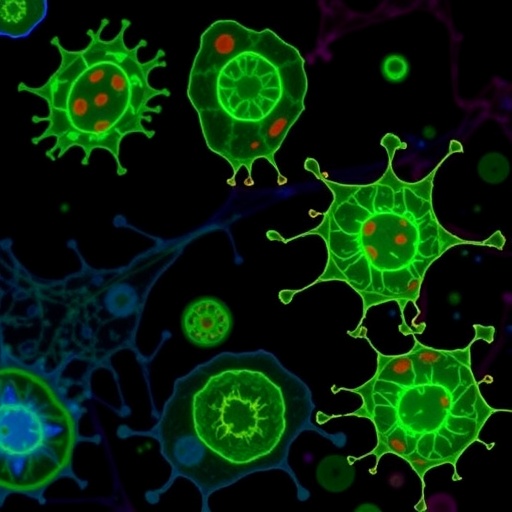In the relentless quest to conquer breast cancer, researchers at the Sylvester Comprehensive Cancer Center, part of the University of Miami Miller School of Medicine, have identified a breakthrough approach that could redefine treatment paradigms for hormone-resistant estrogen receptor-positive (ER+) breast cancers. These cancers, which make up a substantial portion of breast cancer diagnoses, have long been treated effectively with endocrine therapies such as tamoxifen and fulvestrant. However, resistance to these treatments inevitably develops in many patients, leading to disease progression and limited therapeutic options. The new findings unravel pivotal cellular mechanisms driving this resistance and propose an innovative triple-combination therapy that strikes at the tumor and its microenvironment simultaneously.
Central to this discovery is the tumor microenvironment—the complex and dynamic “neighborhood” surrounding cancer cells that includes various types of immune cells, stromal components, and signaling molecules. Within this milieu, tumor-associated macrophages (TAMs) emerge as critical players. These immune cells, normally involved in tissue repair and defense, are co-opted by tumors to support malignant progression. Researchers focused on a specific TAM subtype characterized by the expression of CD163 and the immune checkpoint molecule PD-L1. PD-L1 is known for its role in helping cancer cells evade immune detection, famously targeted by immune checkpoint inhibitors in various cancers.
The Sylvester team found that these PD-L1-positive TAMs accumulate in greater numbers within tumors from patients that developed resistance to tamoxifen therapy. Acting like “bodyguards” shielding the cancer from immune attack and therapy-induced death, these macrophages create an immunosuppressive niche that fosters tumor survival and regrowth. Their recruitment is orchestrated by DLL1, a signaling ligand secreted by the cancer cells themselves. DLL1 initiates a chemotactic cascade, operating through the CCR3/CCL7 pathway, to draw these macrophages into the tumor microenvironment.
This macrophage infiltration not only supports cancer cell survival but also maintains a subpopulation of cancer stem cells—an inherently resilient fraction of tumor cells capable of self-renewal and fueling tumor recurrence. Moreover, the presence of PD-L1-positive TAMs induces exhaustion of cytotoxic CD8+ T cells, the immune system’s frontline soldiers against malignancy. The combination of immune evasion and sustained cancer stem cell populations underscores the complexity and resilience of tamoxifen-resistant breast tumors.
To dissect this resistance mechanism and explore therapeutic interventions, researchers developed two preclinical models of ER+ breast cancer that mimic endocrine therapy resistance. In these models, blocking DLL1 and PD-L1 simultaneously with targeted antibodies, in conjunction with low-dose tamoxifen, led to marked reduction in tumor size. Tumor burden was further diminished by a significant decrease in cancer stem cell populations. This triple-therapy approach not only disrupted the protective macrophage niche but also reactivated the immune response by revitalizing exhausted T cells, effectively tipping the scales back against the cancer.
What sets this approach apart from previous strategies is its multipronged attack—targeting tumor cell signaling, dismantling the supportive immune microenvironment, and applying conventional hormone therapy at subtherapeutic doses to minimize side effects. The findings were validated both in preclinical models and patient-derived explant cultures, underscoring translational potential.
Of particular clinical significance, high levels of DLL1 and PD-L1+ TAMs in human tumors correlated strongly with poor patient outcomes and resistance to both tamoxifen and fulvestrant. These data suggest that quantifying these markers could aid in patient stratification and therapeutic decision-making in the future. The implication is profound: by interrupting DLL1-mediated recruitment of immunosuppressive macrophages and blocking PD-L1 checkpoint signaling, we may overcome a major hurdle in endocrine therapy resistance.
Despite the excitement, Dr. Rumela Chakrabarti, senior author and co-director of the Sylvester Surgical Breast Cancer Research Group, emphasizes cautious optimism. Extensive in vivo validation and early-phase clinical trials are necessary before this strategy can be widely implemented. Human tumors exhibit heterogeneity and complexity beyond preclinical models, requiring thorough investigation of potential side effects and resistance mechanisms to the triple therapy.
The broader scientific significance of this work lies in shifting the focus from cancer cells in isolation to the intricate ecosystem in which they thrive. Tumors are not merely rogue cell populations but communities of diverse cells interacting dynamically. Understanding and targeting these interactions—especially how malignant cells exploit immune cells to evade destruction—open new frontiers for cancer treatment.
This research also contributes to the expanding narrative of cancer immunotherapy, demonstrating how traditional hormone therapies can be synergized with immune modulation to tackle resistant tumors. Such integrated approaches may herald a new era wherein cancers previously deemed untreatable with endocrine therapy become manageable chronic conditions.
In conclusion, the identification of DLL1-responsive PD-L1+ tumor-associated macrophages as key mediators of endocrine resistance offers a compelling target for therapy. The triple combination of anti-DLL1, anti-PD-L1, and low-dose tamoxifen holds remarkable promise in preclinical settings, illuminating a path toward improved outcomes for patients suffering from stubborn ER+ breast cancer. As research progresses, this strategy could redefine standards of care, illustrating the power of dissecting the tumor microenvironment to unlock innovative, life-saving therapies.
Subject of Research: Endocrine resistance in estrogen receptor-positive (ER+) breast cancer mediated by tumor-associated macrophages.
Article Title: DLL1-responsive PD-L1+ tumor-associated macrophages promote endocrine resistance in breast cancer
News Publication Date: November 5, 2025
Web References:
- Sylvester Comprehensive Cancer Center
- Science Translational Medicine Article DOI
- InventUM blog
- SylvesterCancer on X
Image Credits: Photo by Sylvester Comprehensive Cancer Center
Keywords: Breast cancer, tumor-associated macrophages, endocrine therapy resistance, estrogen receptor-positive, PD-L1, DLL1, cancer stem cells, tumor microenvironment, immune checkpoint inhibition, tamoxifen resistance, fulvestrant resistance, immunosuppression




